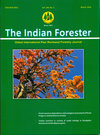Forest Resource Dependence and Ecological Assessment of forest Fringes in Rainfed Districts of India
DOI:
https://doi.org/10.36808/if/2018/v144i3/122725Keywords:
Rainfed Area, Fringe Communities, Fringe Forest, Ecological Status.Abstract
Rainfed areas, which suffer due to lack of sufficient irrigation facilities, depend heavily on the rains for agriculture, thereby exacerbating significantly the dependence of the forest fringe communities on the forests for meeting their subsistence needs. Fringe forests safeguard the interior core forests as long as anthropogenic pressure does not exceed their resilience. However, phenomenal increase in the human and cattle populations and lack of effective management interventions in the fringe areas, is affecting not only the fringe forests but also the core forests. This has culminated in over-exploitation of the forest resources and led to the diminishing supply of goods and services from the forests. A quantitative assessment of the dependence of the fringe communities on the forest and the resultant ecological implications on the forest and biodiversity is imperative to understand the situation and plan for remedial measures in fringe areas as well as fringe forests. A nationwide study was, therefore, undertaken by Forest Research Institute (FRI), Dehradun in 275 rainfed districts spread in 27 States and 1 Union Territory of India covering more than one lakh forest fringe villages. This paper highlights the significance of the study and presents major findings, which can serve as a vital information for various stakeholders concerned with the forest, biodiversity and rural development.References
Census of India. (2011). Houselisting and Housing Census Schedule. Ministry of Home Affairs. Office of Registrar General and Census Commissioner, Government of India, New Delhi.
Champion H.G. and Seth S.K. (1968). A Revised Survey of Forest Types of India. Manager of Publications, Government of India, New Delhi.
Cochran W.G. (1977). Sampling Techniques (Third edition). John Wiley & Sons, New York. 72-86 pp.
FSI (2002). The Manual of Instructions For Field Inventory. Forest Survey of India, Ministry of Environment, Forest and Climate Change, Dehradun.
FSI (2011). India State Forest Report 2011. Forest Survey of India, Ministry of Environment, Forest and Climate Change, Dehradun.
Shannon C.E. (1948). A mathematical theory of communication. Bell System Technical Journal, 27: 379-423. http://censusindia.gov.in/
Downloads
Downloads
Published
How to Cite
Issue
Section
License
Unless otherwise stated, copyright or similar rights in all materials presented on the site, including graphical images, are owned by Indian Forester.





